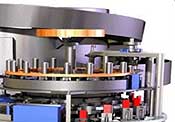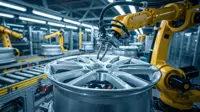Turbo-charge engineering drawings
By John J. McEleney | 30 Aug 2004
2D
or 3D product development? It''s no longer an either /
or question, because the transition to 3D both supports
and enhances a manufacturer''s reliance on 2D
 For
two decades, a debate has raged over migrating from 2D
to 3D for product development. Should manufacturers totally
embrace 3D, eliminate 2D, and make significant changes
to their product development processes? Should companies
phase in 3D computer aided design (CAD), maintaining 2D
development processes for the sake of continuity while
pursuing the productivity benefits of 3D? Why should a
design organisation migrate from 2D to 3D CAD for product
design at all?
For
two decades, a debate has raged over migrating from 2D
to 3D for product development. Should manufacturers totally
embrace 3D, eliminate 2D, and make significant changes
to their product development processes? Should companies
phase in 3D computer aided design (CAD), maintaining 2D
development processes for the sake of continuity while
pursuing the productivity benefits of 3D? Why should a
design organisation migrate from 2D to 3D CAD for product
design at all?
Manufacturers have faced these questions since the introduction of 3D CAD technology and its potential benefits, including faster times to market, higher quality products, greater product innovation, and lower development costs. Even though 3D technology yields proven, well-documented productivity gains, many product development groups continue to utilise 2D CAD as their fundamental design tool, adhering to the old adage, "If it''s not broken, don''t fix it."
This
reasoning stems from the way many CAD vendors have couched
the 2D-to-3D migration debate, the notion that 3D represents
a total replacement for 2D, an either / or situation,
when in reality some 3D systems, provide a better, easier,
faster means for producing the same engineering drawings
created in 2D systems.
3D Goes Mainstream
In his bestseller Crossing the Chasm, Geoffrey
A. Moore describes the stages of the technology adoption
lifecycle, which have clear parallels to 3D CAD. With
virtually all new technologies, there are early adopters,
who are so enamoured with the technology that they are
willing to accept a certain degree of risk and disruption
in exchange for the potential benefits of the solution,
and mainstream users, who take a more cautious approach,
weighing the benefits of a solution against the impact
of change.
Early adopters seek revolutionary change, expect extreme discontinuity between the old and the new, and are willing to deal with the glitches that inevitably accompany any innovation. Mainstream users want technology to enhance rather than overthrow established processes, are highly resistant to change, and have little tolerance for deviations and imperfections.
In the case of 3D CAD, early adopters perceived 3D as a total replacement for 2D and were willing to accept some of the technology''s growing pains to bring better products to market faster and more cost-effectively. Rebuilding models for analysis and legacy data management, and ignoring the need for drawings are examples of these growing pains. The perception that 2D and 3D are either / or solutions is a myth that originated with early 3D systems.
 Today,
3D has entered the mainstream in the technology lifecycle.
Mainstream users benefit greatly from mature 3D technology
because many of the potential problems associated with
early 3D systems have been addressed. However, to support
mainstream users effectively, 3D technology development
must focus on enhancing rather than disrupting existing
2D processes. Whether a manufacturer uses 2D or 3D CAD
tools, the final deliverable continues to be a 2D engineering
drawing and will remain so for the foreseeable future.
To meet the needs of mainstream users, 3D vendors need
to develop capabilities and innovations that make drawing
production easier.
Today,
3D has entered the mainstream in the technology lifecycle.
Mainstream users benefit greatly from mature 3D technology
because many of the potential problems associated with
early 3D systems have been addressed. However, to support
mainstream users effectively, 3D technology development
must focus on enhancing rather than disrupting existing
2D processes. Whether a manufacturer uses 2D or 3D CAD
tools, the final deliverable continues to be a 2D engineering
drawing and will remain so for the foreseeable future.
To meet the needs of mainstream users, 3D vendors need
to develop capabilities and innovations that make drawing
production easier.
A
Better Way
While the final deliverable in product development continues
to be a 2D drawing, the route taken to reach that destination
is quite different. When compared to 3D, designing in
2D involves a plethora of challenges that impede productivity,
extend design cycles, raise the probability of quality
issues, and increase costs. A modern 3D CAD system, such
as SolidWorks, can resolve these issues either by eliminating
them completely or by providing a more efficient solution.
Some of the advantages of 3D include:
- creating drawings instantly — creating different drawing views (e.g., isometric, exploded assembly, detail, section, etc.) in 2D requires additional work to redraw the design. Most 3D systems create drawing views automatically from the solid model.
- communicating design intent — visualising 2D drawings as 3D parts or assemblies can be difficult, and misinterpretation of drawings can result in a loss of the engineer''s original design intent, leading to delays and rework. 3D systems eliminate the potential for drawing misinterpretation.
- assessing fit and tolerance problems — trying to evaluate the fit, interface, and function of assembly components from 2D drawings can result in fit and tolerance problems that often go undetected until late in the design cycle. In 3D, engineers can assess and resolve fit and tolerance problems during initial design.
- handling large, complex assemblies — designing large, complex assemblies in 2D is tedious, labour-intensive, and slow because of the need to manage numerous production-level drawings. With 3D, this tedium is eliminated.
- minimising reliance on physical prototyping — visualising the performance of an assembly in 2D requires extensive physical prototyping. The same process can be done on the computer in 3D, saving time and money.
- making quick, easy design changes — making design changes in 2D involves manual changes to all drawing views. With 3D, a design change automatically propagates to all related drawings and views.
- configuring derivative products — whenever products involve varying sizes, dimensions, weights, or capacities, each assembly must be redrawn separately in 2D. 3D enables the designer to generate families of part and assembly configurations from a single part or assembly.
- improving
support for documentation, publication, and marketing
— additional work is required with 2D to create
customised isometric and exploded assembly views for
documentation, publication, and marketing. In 3D, all
graphics, drawings, and exploded assembly illustrations
can be exported easily from the solid model.
A
Painless Transition
By evaluating 3D CAD systems in terms of their application
to existing 2D-based design and manufacturing processes
as well as in terms of 3D capabilities, mainstream manufacturers
can set the stage for a productive, undisruptive transition
to 3D.
Richmond-based Silvertip Design, a research and design firm that is collaborating with a group of universities and private companies to design, build, and test a hybrid vehicle that functions as both a train and a bus, has made the transition. The firm, which had used 2D tools prior to implementing SolidWorks 3D software, decided to migrate to 3D for creating and visualising complex geometries and large assemblies, such as the undercarriage that houses both rubber tires and retractable train wheels, according to Carl Henderson, owner of Silvertip Design.
"SolidWorks made the transition from 2D painless so that we could concentrate our energies on designing a new transportation paradigm," Henderson explains. "We could map out all the possible angles for the ball joints (between the connection links and the wheels) in every steering position and animate the solid model so that we could see problems and fix them. It helped us reduce the number of prototypes and provide a smooth ride by ensuring we position the ball joints to provide the best performance for the vehicle."
Silvertip produces drawings from solid models, makes design changes quickly and easily, and leverages models for other applications using COSMOSWorks analysis software to assess the impact of loads on parts and assemblies and CAMWorks software to machine parts directly from the SolidWorks design, which saves time and money.
Xaar PLC, a leading developer and manufacturer of high-performance digital printing technology, is another UK-based company that has benefited greatly from the transition to 3D. "We needed a 3D CAD package that would dramatically reduce the time and tedium of designing new, complex products with dozens of 2D drawings," notes Robert Ison, project leader at Xaar. "We can do so much more with SolidWorks 3D design methods than we ever could in 2D. And, we can design everything in far greater depth. As a result, we are seeing a nearly 50-per cent increase in productivity."
Drawing
Innovations
In addition to providing a range of productivity benefits,
3D systems provide innovative capabilities for further
automating drawing production. The software not only produces
all types of drawings and views instantly from the 3D
solid model but also automatically creates drawing details,
such as dimensions, and provides tools for displaying
parts lists, bills of materials (BOMs), and hole tables.
Other drawing innovations include eDrawings, which enables engineers to email drawings in compact, self-executing files to collaborators, suppliers, vendors, and customers, and XchangeWorks, a data translation plug-in for leading 2D CAD tools.
Designing in 3D provides a range of benefits that help manufacturers produce higher quality, more innovative products faster and at less cost. While the degree to which manufacturers reap these benefits is often system-dependent, 3D CAD systems have improved substantially since their inception and will continue to grow and evolve. Now that 3D CAD has entered the mainstream in terms of its technology lifecycle, supporting 2D has become more important than ever.
*
The
author is president and chief executive officer, SolidWorks
Corporation.






















